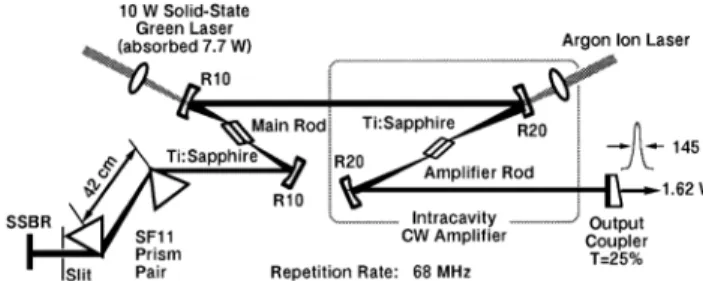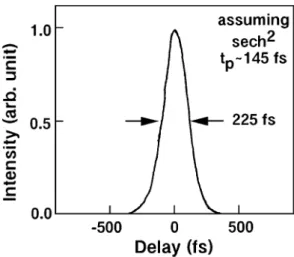This content has been downloaded from IOPscience. Please scroll down to see the full text.
Download details:
IP Address: 140.113.38.11
This content was downloaded on 28/04/2014 at 08:58
Please note that terms and conditions apply.
High Average Power Mode Locked Ti:Sapphire Laser with Intracavity Continuous-Wave
Amplifier and Strained Saturable Bragg Reflector
View the table of contents for this issue, or go to the journal homepage for more 1999 Jpn. J. Appl. Phys. 38 L1109
(http://iopscience.iop.org/1347-4065/38/10A/L1109)
Jpn. J. Appl. Phys. Vol. 38 (1999) pp.L1109–L1111 Part 2, No. 10A, 1 October 1999
c
°1999 Publication Board, Japanese Journal of Applied Physics
High Average Power Mode Locked Ti:Sapphire Laser with Intracavity Continuous-Wave
Amplifier and Strained Saturable Bragg Reflector
Tze-An LIU∗, Kai-Fung HUANG1, Ci-Ling PAN, Zhenlin LIU2, Hideyuki OHTAKE2and Nobuhiko SARUKURA2 Institute of Electro-Optical Engineering, National Chiao Tung University, 1001 Ta-Hsueh Road, Hsinchu 30010, Taiwan
1Department of Electrophysics, National Chiao Tung University, 1001 Ta-Hsueh Road, Hsinchu 30010, Taiwan 2Institute for Molecular Science (IMS), Myodaiji, Okazaki 444-8585, Japan
(Received July 13, 1999; accepted for publication August 16, 1999)
We demonstrate a new scheme for the generation of high average power femtosecond pulses by incorporating an intra-cavity amplifier and a strained saturable Bragg reflector with low saturation fluence for self-starting mode locking. When the Ti:sapphire oscillator and intracavity amplifier are pumped at 10 W and 15 W, respectively, the average output power is as high as 1.62 W. The pulse duration is about 145 fs, and the peak power reaches 160 kW at a 68 MHz repetition rate. The pulse-formation time of 400µs is sufficiently short to sustain stable mode locking.
KEYWORDS: High average power, mode locking, Ti:sapphire laser, strained saturable Bragg reflector (SSBR), intracavity continuous-wave amplifier
∗E-mail address: u8524809@cc.nctu.edu.tw
L1109
Over the last few years, great strides have been made in the development of femtosecond solid state lasers mode-locked either by the Kerr lens effect1)or by saturable absorbers.2)For
application to nonlinear optics, time-resolved spectroscopy or THz-radiation generation, average or high peak power fem-tosecond laser systems can significantly improve the experi-mental results. Recently, high peak power (∼MW) Kerr-lens mode-locked Ti:sapphire laser generating about 10 fs pulses has been demonstrated using mirror-dispersion-controlled3)
with a 100 MHz repetition rate. Cavity dumped oscillator with a repetition rate of 200 kHz, 13 fs pulse duration, and 5 MW peak power or similar performance with multiple-pass cavity geometry4) at 15 MHz has been demonstrated.5) Re-cent studies also demonstrated the generation of 10 W average power and 7.8 kW peak power with 16 ps optical pulses by a diode-pumped, passively mode-locked Nd:YAG laser.6) How-ever, there are some difficulties in power scaling the ultrafast mode-locked lasers. The higher average power is important for the generation of THz-radiation7) or the intracavity
dou-bling of a femtosecond laser.8)Recently, Liu et al.9)reported
an average power-scaled femtosecond Ti:sapphire laser with an intracavity continuous-wave (CW) amplifier. The output power was almost doubled to 3.4 W with a 79 MHz repeti-tion rate. However, a dye jet was used for self-starting the mode locking. This was a significant drawback of the pre-vious system. To maintain femtosecond pulses at a high av-erage power, a scheme to achieve self-starting mode locking is required. Thus, solid-state saturable absorbers are desir-able. In most cases, tight focusing of the intracavity beam was required to achieve the required saturation intensity.10) Such intracavity focusing increases the possible risk of op-tical damage to the delicate saturable absorber, particularly in the case of high average power operation. In this paper, we propose and demonstrate a compact, high output power femtosecond mode-locked laser that does not require the in-tracavity beam to be focused on the saturable absorber. This is realized by incorporating a previously developed strained saturable Bragg reflector (SSBR)11)with a saturation fluence
as low as 7 mJ/cm2with an intracavity CW amplification
sys-tem.
The laser cavity with two 1-cm-long Brewster-cut
which was focused through a 20-cm-focal-length lens onto the amplifier rod. The laser output power increased linearly with the amplifier pumping power (see Fig. 2), and the behav-ior is the same as that of the dye jet mode-locking system.9)
With a 10 W green laser pumping the main rod and a 15 W argon ion laser pumping the amplifier rod, the laser power reached 1.62 W with a 145 fs pulse width. The autocorrela-tion trace and spectrum of the transform-limited pulse train are shown in Figs. 3 and 4, respectively. The corresponding Ti:sapphire rods is shown in Fig. 1. The Z-folded cavity con-tains two 10 cm and two 20 cm radius of curvature folding mirrors which focus the intracavity laser beam on the main and amplifier rods, respectively. A 10 W solid-state green laser (Millennia X, Spectra Physics) was focused through a 10-cm-focal-length lens on the main laser rod. Intracavity dis-persion compensation was provided by a pair of SF11 Brew-ster prisms separated by about 42 cm. The SSBR,11) which
served as the saturable absorber for passive mode-locking, was placed in the end mirror position of the dispersion-compensation arm. A slit was put between the SSBR and the adjacent prism to tune and stabilize the laser wavelength and to reduce the timing-jitters. Due to the low saturation inten-sity of the SSBR, we can use a rather high transmission (25%) output coupler for producing higher output power and main-tain the mode-locking without focusing on the SSBR. With-out pumping the amplifier rod, the With-output average power of the Ti:sapphire laser was 1.1 W, and nearly transform-limited 130 fs pulses can be generated. The center wavelength of the laser was about 787 nm with a spectral width of 5.8 nm.
The intracavity amplifier was pumped by an argon laser
Fig. 1. Cavity configuration of the compact, high average power mode-locked femtosecond Ti:sapphire laser with intracavity CW ampli-fier
time and bandwidth product was 0.36. The peak power of the laser reaches 160 kW with a 68 MHz repetition rate, which is slightly lower than the previous case which used a dye jet,9)
and is partly due to higher loss in the cavity.
The pulse build-up time was also measured to evaluate the self-starting performance of the laser. A chopper with a fre-quency of about 87 Hz was put inside the cavity. The funda-mental pulse train was measured using a photodiode detector with a fast (∼1 ns) response time.2, 12, 13)The pulse evolution was recorded using a 400 MHz storage oscilloscope, as shown in Fig. 5. After the relaxation oscillation, the time taken to reach the steady state was about 400µs with high stability. Compared with the pulse build-up time (∼5 ms) of the mode-locked Ti:sapphire laser with the SSBR but without an intra-cavity amplifier, this build-up time was significantly shorter. This is reasonable, since the intracavity pulse energy is higher in the present system.
In summary, we have reported a new type of femtosecond amplification scheme in which an SSBR with low saturation fluence was used for self-starting mode locking, and an in-tracavity CW amplifier system was used to scale the aver-age output power. As the amplifier rod was pumped from 0 W to 15 W, the output power linearly increased from 1.1 W
to 1.62 W, and stable mode locking was sustained. Com-pared with our previous system using the dye jet saturable absorber, the present system is more compact and stable, and exhibits lower noise. To our knowledge, this is the highest average power reported for a mode-locked Ti:sapphire laser with a semiconductor saturable absorber. The peak power of the laser reaches 160 kW, with a 145 fs pulse duration and a 68 MHz repetition rate. The pulse formation time of 400µs was short enough to sustain stable self-starting mode locking. By optimizing the output coupling, increasing the pumping power and fine tuning the cavity, we expect to achieve an even higher output power with reduced pulse width.
The authors are grateful for the support of the National Sci-ence Council of the Republic of China under various grants. This work is partially supported by the Sasakawa Scientific Grant, Research foundation for Opto-science and Technol-ogy, and the Grant-In-Aid for Science Research from the Japanese Ministry of Education, Science, Sports and Culture. We are very grateful to Eiji Kawahata, Toshimasa Kozeki, and Shingo Ono for their assistance in the experiment.
1) D. E. Spence, P. N. Kean and W. Sibbett: Opt. Lett. 16 (1991) 42. 2) N. Sarukura and Y. Ishida: Opt. Lett. 17 (1992) 61.
3) L. Xu, G. Tempea, C. Spielmann, F. Krausz, A. Stingl, K. Ferencz and S. Takano: Opt. Lett. 23 (1998) 789.
Fig. 3. Autocorrelation trace of the output pulse with 1.62 W output power. The pulse width is measured to be about 145 fs assuming a sech2 pulse shape.
Fig. 2. Amplified power dependence on the argon ion laser pumping power.
Fig. 5. Pulse build-up trace with fast response photodiode detector which was recorded using a 400 MHz storage oscilloscope. The mode locking starting time was calculated to be about 400µs.
Fig. 4. Optical spectrum of center wavelength at 783 nm, spectral width around 5.13 nm.
9) Z. Liu, S. Izumida, S. Ono, H. Ohtake and N. Sarukura: Appl. Phys. Lett. 74 (1999) 3622.
10) S. Tsuda, W. H. Knox and S. T. Cundiff: Appl. Phys. Lett. 69 (1996) 1538.
11) J. M. Shieh, T. C. Huang, K. F. Huang, C. L. Wang and C. L. Pan: Opt. Commun. 156 (1998) 53.
12) J. C. Kuo and C. L. Pan: Opt. Lett. 15 (1990) 1297.
13) J. Goodberlet, J. Wang, J. G. Fujimoto and P. A. Schulz: Opt. Lett. 15 (1990) 1300.
Jpn. J. Appl. Phys. Vol. 38 (1999) Pt. 2, No. 10A T.-A. LIUet al. L1111 4) S. H. Cho, B. E. Bouma, E. P. Ippen and J. G. Fujimoto: Opt. Lett. 24
(1999) 417.
5) A. Baltuska, Z. Wei, M. S. Pshenichnikov, D. A. Wiersma and R. Szipocs: Appl. Phys. B 65 (1990) 175.
6) G. J. Spüler, R. Paschotta, U. Keller, M. Moser, M. J. P. Dymott, D. Kopf, J. Meyer, K. J. Weingarten, J. D. Kmetec, J. Alexander and G. Truong: Opt. Lett. 24 (1999) 528.
7) N. Sarukura, H. Ohtake, S. Izumida and Z. Liu: J. Appl. Phys. 84 (1998) 654.

